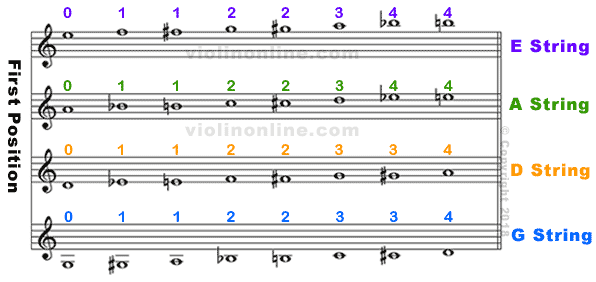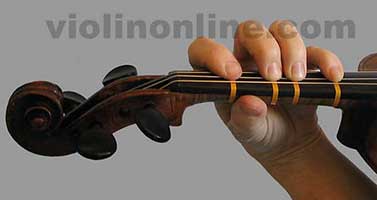LET'S TRY USING VIOLIN FINGERING! The following D scale starts on the open D string. See how the 0 for open string is the color gold? And, the next 3 notes with the fingering numbers 1, 2, 3, are also gold? Play all of these notes on the D string. When the color of the fingering numbers changes to green, play all of these notes on the A string. Each note is a whole note, so hold each note for 4 beats, using long, smooth bows.
Half steps and whole steps. Notice how there’s a “V” shape connecting the 2nd and 3rd fingering numbers? That means the second and third finger are right next to each other – the notes are a half step away. See how the image of the hand shows the 2nd and 3rd fingers are right next to each other? The image of the hand also shows the 1st and 2nd fingers aren’t touching – these notes have a whole step between them. Even though the D, G and A scales being used as examples in this lesson have a half step between the 2nd and 3rd finger, other scales have different half steps and whole steps between the notes. Violin Lesson #3, Finger Patterns, will demonstrate some of these variations.
4th finger or open string? It’s your choice! Notice how when you’re going up the D scale, open A is shown with a green 0 for open A (no fingers on the string). Coming down the D scale, you’re given two choices to play A: a green 0, no fingers, for open A, or, 4th finger on the D string. The pitch of the note should be the same. Compare the two. Does your 4th finger on the D string sound the same pitch as your open A? They should match. When fingering violin music, there will be times when it will be easier to use your 4th finger instead of an open string.
Fingerboard confusion? Having trouble remembering where to place your fingers on the fingerboard? Many beginning violinists use fingering tape as a temporary aid to help them place their fingers on the violin fingerboard. Visit our Fingering Tape section for finger placement assistance. If you need help reviewing how to read violin music, visit our Reading Violin Music section.
Bonus sound file: For fun, play the D scale above with this D major scale duet sound file and sheet music:






